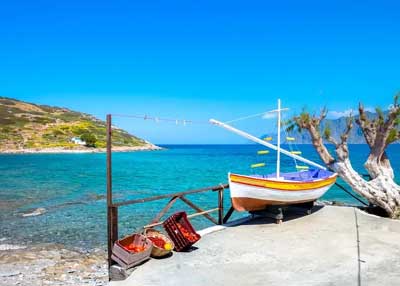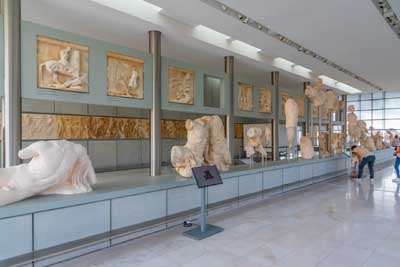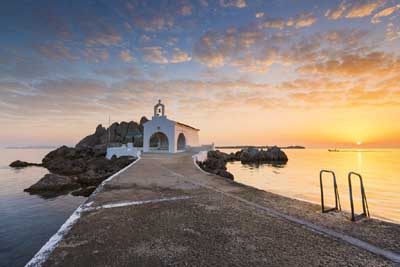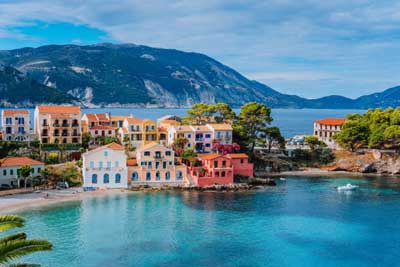
How to get off the tourist trail in Greece
Helen Iatrou
Athens: A dreamy vacation in Greece is, without a doubt, more sought-after than ever. The Mediterranean destination has already surpassed prepandemic visitor numbers.
In 2023, the country of 11 million received over 32.7 million international arrivals compared to 31.3 million in 2019. Credit ratings agency Fitch expects this figure to reach 34.5 million in 2024, prompting concerns about overtourism.

While most visitors tend to make a beeline for antiquity-rich Athens, the whitewashed cave houses of Santorini, and glitzy party isle Mykonos, there’s much more to explore in Greece. That’s not to say you shouldn’t visit this much-loved trio. There are simply better ways to go about it. For one, I’d recommend avoiding the peak summer crush. You won’t enjoy sweating your way between ancient sites in the city or jostling for elbow room to capture a photo of Santorini’s famed sunsets. More importantly, it’s worth giving these destinations a breather. You’ll have a better time and everyone who makes up the tourism industry, from hoteliers to restaurant staff and shopkeepers, can serve you better. Furthermore, planning a trip during shoulder seasons translates to a longer season. This results in additional income for hospitality industry employees and the small and medium-size businesses that constitute the bulk of Greece’s tourism sector.

Outside the big three, countless island and mainland destinations see fewer visitors and need vital tourist dollars, including foodie favorite Lesvos and stunning Thassos in the lesser-visited North Aegean as well as the mountain villages of Epirus in northwestern Greece. So go ahead and spread the love. You’ll discover somewhere new and simultaneously boost the local economy. Here’s how to enjoy everything great about Greece without the crowds.
Witnessing the engineering marvel that is the fifth-century Parthenon crowning Athens’s Acropolis hill is, undoubtedly, an experience of a lifetime. Most travelers tend to mill around the city’s ancient sites and a handful of museums, including the treasure-filled Acropolis Museum and the National Archaeological Museum. But once you’ve had your fill of the center’s cultural attractions, venture to lively neighborhoods a short walk or underground Attiko Metro ride away and you’re likely to see few, if any, fellow visitors.

Despite its patience-testing traffic, city center of wobbly sidewalks, and rising rents thanks to the proliferation of Airbnbs, I couldn’t imagine living anywhere else but in the Greek capital. Athenians know how to have fun, and I’ve always felt it’s one of the safest urban centers in the world. Where I live, on the southern Athens coast, I’m in easy reach of some of its best beaches. Among my choice swimming spots is glittering Vouliagmeni Bay. In summer, the sandy crescent-shaped beach fills with sun worshippers. Stretch out on a sun lounger, gather your crew for a game of volleyball on the sand, or play with the kids in the shallows. At night, the twinkle of super-yacht lights illuminate the natural harbor dotted with upscale fish restaurants and café-bars.

Once summer arrives, I mostly avoid the city center. Sizzling temperatures in July and August make densely populated, cement-heavy downtown almost unbearable. Athens, the first European city to appoint a Chief Heat Officer who now serves as Global Chief Heat Officer to U.N. Habitat and the Arsht Rock Resilience Center, experienced a record-breaking heatwave in the summer of 2023. The Acropolis even closed during the hottest hours of the day to keep visitors safe. I retreated indoors, reluctantly relying on air-conditioning.

Consider timing your Athens jaunt between November and February, during the city’s off-season. Hotel rates are significantly lower, ancient sites and museums are nearly empty, and the weather is, for the most part, pleasant. It does get cold and can rain, so pack appropriately. This is also when you’ll get a real feel for Athenian city life, as locals are out and about, lingering at cafés, hobnobbing at wine bars, and dining till late. Order an espresso freddo in hipster magnet Pagrati at Veniamin on Mesologgiou Square or Foyer. Bibliophiles can lose themselves down a literary rabbit hole in anti-establishment Exarchia, which is full of quirky bookstores like that of independent publishing house Aiora.

Skip the National Gardens in downtown Athens and spend time strolling around the Mediterranean herb-filled gardens of the fully accessible Renzo Piano–designed Stavros Niarchos Foundation Cultural Center (SNFCC) instead. Much loved among locals in a city sorely lacking in green space, the complex hosts free outdoor concerts (weather permitting) throughout the year. Rent a bike from the SNFCC parking station and roam around the grounds. Let youngsters loose on eco-playgrounds built of wood and featuring ancient-inspired games. In the evening, catch a ballet, opera, or theater performance at the Greek National Opera’s grand Stavros Niarchos Hall.
While Athens has seen its fair share of Michelin debuts in recent years, one newcomer is quietly crafting culinary miracles in the shade of the Parthenon. Makris Athens’s low-profile chef Petros Dimas, who has worked alongside the U.K.’s Jason Atherton, says he is not shooting for the stars. Still, this dining spot deserves a place in the gourmet galaxy. It’s situated close to pedestrianized Adrianou Street, which links several ancient sites and heaves with visitors between April and October, but stepping inside feels like a secret serene escape. The menu looks to the Ionian island of Corfu for inspiration. Dimas doesn’t shy away from bold flavors or criticism. “I want diners to say ‘I like it’ or ‘I don’t’,” he says. “I like to play around with acidity and intensity and push them to their limits.” He uses Greek ingredients almost exclusively, sourcing produce from his father’s farm in ancient Corinth, red prawns from Argolis, and piquant olive oil from ancient Olympia. If you’re celebrating something special, book the private dining room; its glass floor reveals ancient finds.
Alternatively, check out the flourishing drinks and dining scene in the up-and-coming Neos Kosmos neighborhood, including ever-creative Fita, wine bar Epta Martires, and craft beer bar-cum-specialty grocery store Baubo.
Sure, Santorini is a must-see and Mykonos is always big fun, but there are plenty of islands worth exploring beyond these Hellenic poster children.
While Milos has soared in popularity in recent years thanks mostly to Sarakiniko, whose moon-like landscape and deep blue waters make for an irresistible Insta-backdrop, Santorini’s Cycladic sister is considerably less busy. Some of my most beloved beaches are on Milos, among them secluded Gerondas in the southwest part of the island, with its deep, still waters, and Alogomandra in the northeast, beneath a partially collapsed sea cave.
Mina Agnos, cofounder and president of luxury Greek travel experts Travelive, recommends staying at Melian Boutique Hotel and Spa, a favorite among her clients, or Milos Breeze Boutique Hotel, whose warm, friendly service is unmatched. “Make sure to book a private sailboat, yacht, or RIB to visit the Kleftiko and Sykia sea caves and nearby Poliegos islet, where you can swim in ultramarine waters,” she says. Shopping-wise, Agnos recommends Opsidianos in the port town of Adamas for a wide variety of handmade jewelry and Milos Sand Gallery in the atmospheric hilltop capital Plaka for its fascinating sand exhibits and one-of-a-kind memorabilia.
Understated Syros couldn’t be more different than outlandish Mykonos. But if you’re looking to live the slow island life and appreciate history, walk this way. Immerse yourself in the 19th-century grandeur of Syros’s capital Ermoupolis, whose stately town hall is a work of art. Wander among graceful neoclassical sea captains’ mansions in the aristocratic Vaporia neighborhood, where the Apollon Theater, a miniature replica of Milan’s La Scala, hosts the International Festival of the Aegean in July. Expect orchestral performances, classical music, and opera productions such as Donizetti’s Don Pasquale.
The Vaporia section is where you’ll find the newly opened Argini Hotel, housed in a sensitively restored stone building dating to 1853. Design pieces from the likes of Gessi, Artemide, and Buster + Punch add a contemporary edge. Sleep amid restored wall and ceiling frescoes painted by artists of the time depicting Renaissance elements, mythical creatures, and Greek revolutionary heroes. Unwind at the rooftop plunge pool and bar, atmospheric hammam, and indoor pool before dressing for dinner at in-house restaurant Elexis, where chef Nikos Stamatis weaves island staples like kopanisti cheese and capers into inventive dishes. Fly Cycladic offers inter-island flights between Syros and other islands aboard low-altitude 12-seater planes.
From Tinos to Zakynthos and Kefalonia to Sifnos, chefs raise the bar of Greek island cuisine by preserving long-held family traditions and reimagining local recipes
The Ionian island of Zakynthos is best known for its picture-perfect Shipwreck Beach, which remains closed to the public following a landslide. But it’s also a food lover’s dream come true. Rubys Sakis Kandilas, CEO of Explore Zakynthos and a licensed tour guide, admits to a soft spot for Porto Roma, which he says is one of the island’s oldest and best fish restaurants. If you arrive by boat at the restaurant, situated on the azure bay of the same name, moor up at the floating pier and prepare for a feast of locally caught, masterfully chargrilled fish, ranging from red mullet and common dentex to goldblotch grouper. Meanwhile, at Dafni beach, you’ll find vintage family-run tavernas that operate on generators. They’re not hooked up to the power grid because they are located within a marine park. At Porto Mela, “They bake bread in a wood-fired oven and serve it with olive oil of their own production, tomato, and garlic. I also love the traditional Zakynthian dish rabbit stifado with ladotiri cheese,” Kandilas says.
On Tinos, sample taramosalata dip made with squid ink at seaside Thalassaki and fennel croquettes at Ankyra with a glass of crisp local white assyrtiko wine. Other options include crudo fish dishes at Omega3 and elegantly simple seafood at zero waste–focused Cantina on Sifnos. Off western Greece, in the Ionian islands, Kefalonia is known for hearty homestyle meat pies and family-run taverna Makis, in Vasilikades village, dishes up a tasty one.
